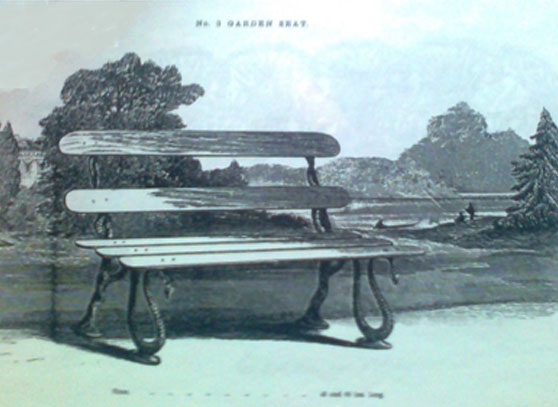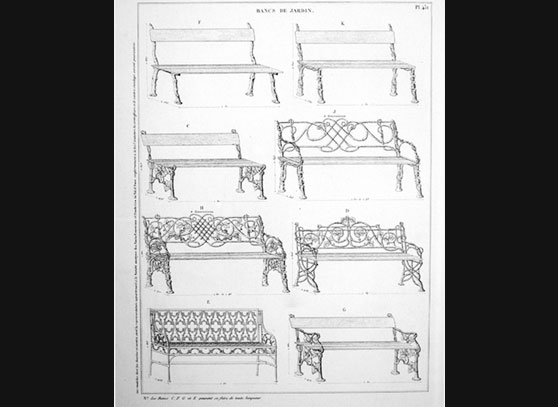Catalogues
Other foundries
A quick round-up of the history of architectural and decorative cast iron will reveal that a few major foundries dominate accounts of the period. Many of these are covered as part of this website. However, it should be remembered that there were many hundreds of foundries around the UK, many of whom were producing rather mundane, everyday goods but occasionally would make a small foray into the productions of more decorative items.

Mapplebeck and Lowe
Based in Birmingham and Sheffield, the company advertised themselves as both silversmiths and foundry ironmongers. They offered an eclectic range of goods, from a patented snuffer to the ‘Automaton Roasting Jack’ an addition to the cooking range to allow for the preparation of whole animals.
The Lost Art Archive reveals that they also produced some garden items as demonstrated by their registration for the design of a bench end in a rustic style.

Barnard, Bishop & Barnard
Based in Norwich, the company was originally formed in 1844 as a supplier of agricultural products. As the company grew, their product range expanded, with a notable project being the supply of a prefabricated cast iron and timber lighthouse, supplied to the Govermment of Brazil.
Decorative ironwork was part of their output, with some particularly notable gates being produced by the company as well as some fine garden furniture. Some of their finest designs were the work of the notable aesthetic designer Thomas Jeckyll, for instance, the “Four Seasons”gates,featuring swallows and doves and branches of trees flowering and bearing fruit. The Lost Art collection includes a fine example of a highly decorative cast iron bench produced from his design.
The Lost Art archive contains documents and catalogues relating to a large number of these less celebrated foundries, including Boulton and Paul, Yates and Heywood, Illingworth and Ingham, and Archibold Kenrick, as well as examples of their work in our collection, all of which are availoable for production. For example, the catalogue produced by the Taylor Brother of Sandiacre reveals them as focussing largely on production for the railway industry. However, they also supplied numerous styles of seating in both cast and wrought iron. As was the state of the copyright laws in that period, many of the designs will also be familiar as being available from their competitors. Incongruously, the last page of their seating catalogue offers a garden roller to customers. It should be noted that the prices quoted have changed somewhat in the intervening years.

Metal Working Companies
Other ironworks focussed less on the casting of iron from patterns and more on the production of fencing and associated products such as gates and tree guards. In addition to the Bayliss Company, there are many other examples, such as Hill & Smith. Based in the Midlands. Lost Art retain a copy of one of their catalogues in the archive and can reproduce any items as required or base new designs on their originals, should a project require this.

Overseas Foundries
Although the UK and Scotland in particular were the world leaders in both industrial and decorative ironwork during the mid to late Victorian period, there were many thousands of foundries across the globe, including some notable producers.
As mentioned earlier, the copyright laws of the time were considerably less defined that is the case today and the same or very similar designs can be found in the catalogues, not only in the same country but literally around the world.

Overseas Foundries
The Serpent bench, offered by Lost Art Limited is often attributed to the influential German von Rolf Foundry but several foundries in the UK alone produced a very similar and largely indistinguishable form of the same bench.

The Val D’osne Foundry
Perhaps the most significant French producer of decorative ironwork, with a vast range, including fountains, statuary and architectural castings.

The Val D’osne Foundry
In a similar vein to the misattribution of the Serpent design, one of their most frequently found bench designs is often attributed to the Val D’Osne Foundry but was in fact originally produced at the Yates and Heywood Foundry in Rotherham.

American Foundries
Two American foundries are particularly noteworthy.
The Stewart Company of Cincinnati, Ohio were particularly noteworthy for their gates and fencing.

The Mott Ironworks
Based in New York, The Mott Company was one of the major producers of both architectural ironworks in the USA. However, many of their designs were close to, if not exact replicas of earlier designs from UK companies.
Mott produced significant numbers of fountains, many of which are very similar to those of several Scottish Foundries, particularly the Sun Foundry of Glasgow, with whom Mott had considerable links.
The Squirrel Bench, originally a Sun Foundry Design was also produced by Mott, with a surviving example not to be found in the gardens of the prestigious Smithsonian Institute.
Lost Art now also have a pattern for the production of The Squirrel Settee (as it was originally known) and have supplied these to various restoration projects and private buyers around the UK.
The Mott Company buildings were eventually destroyed by fire and little of their records remain, however, Lost Art do have access to some of these within our archive.
